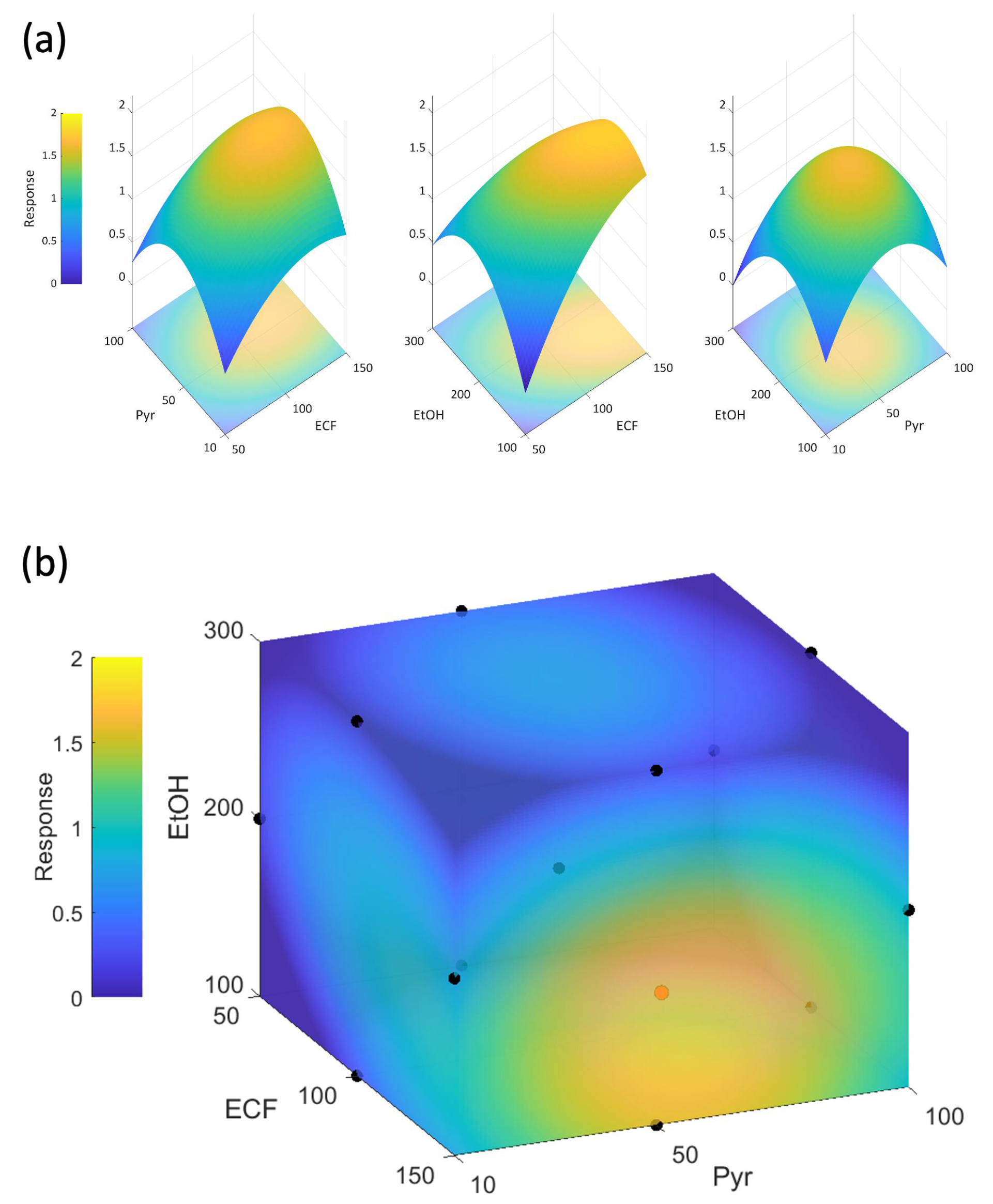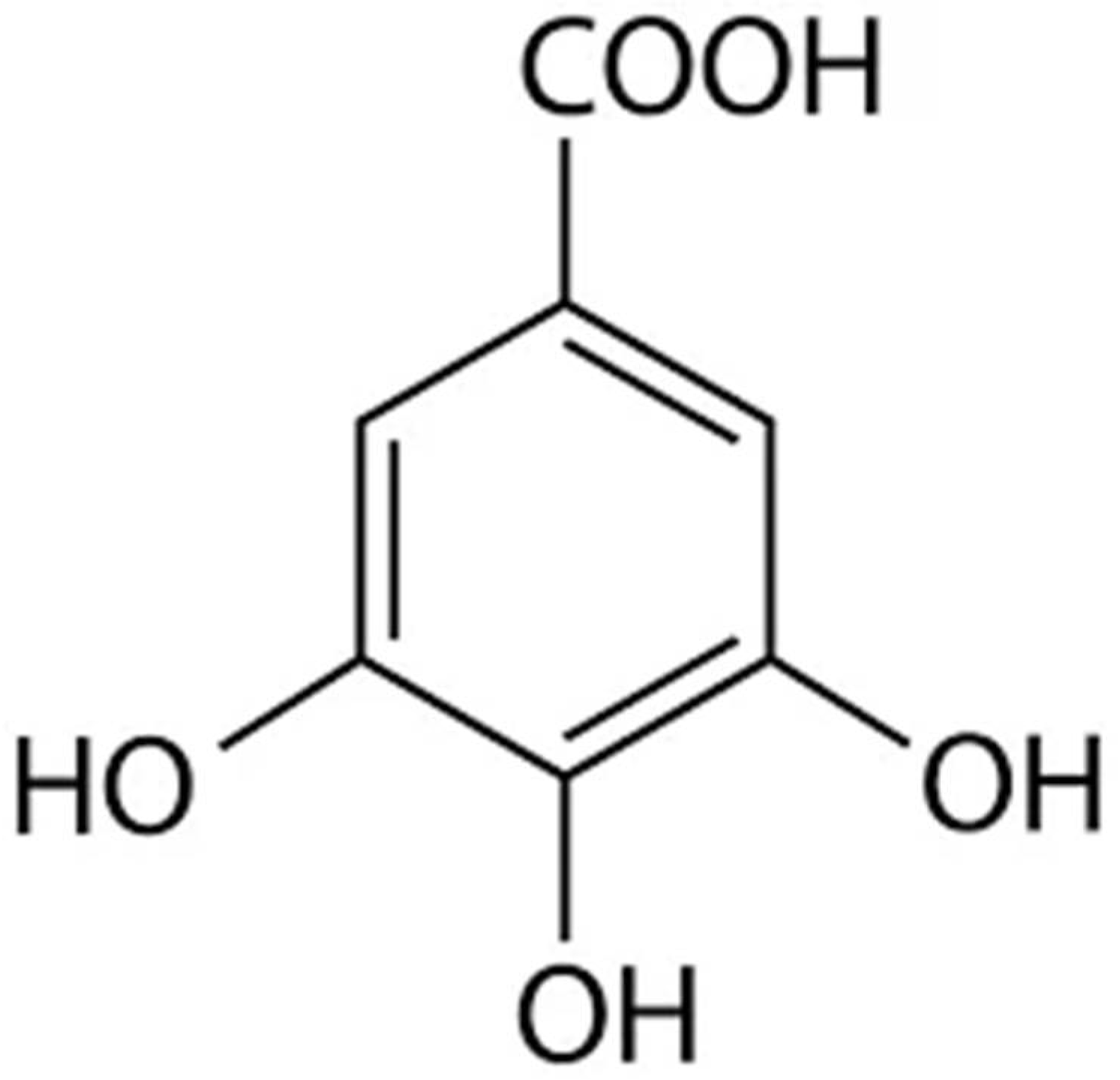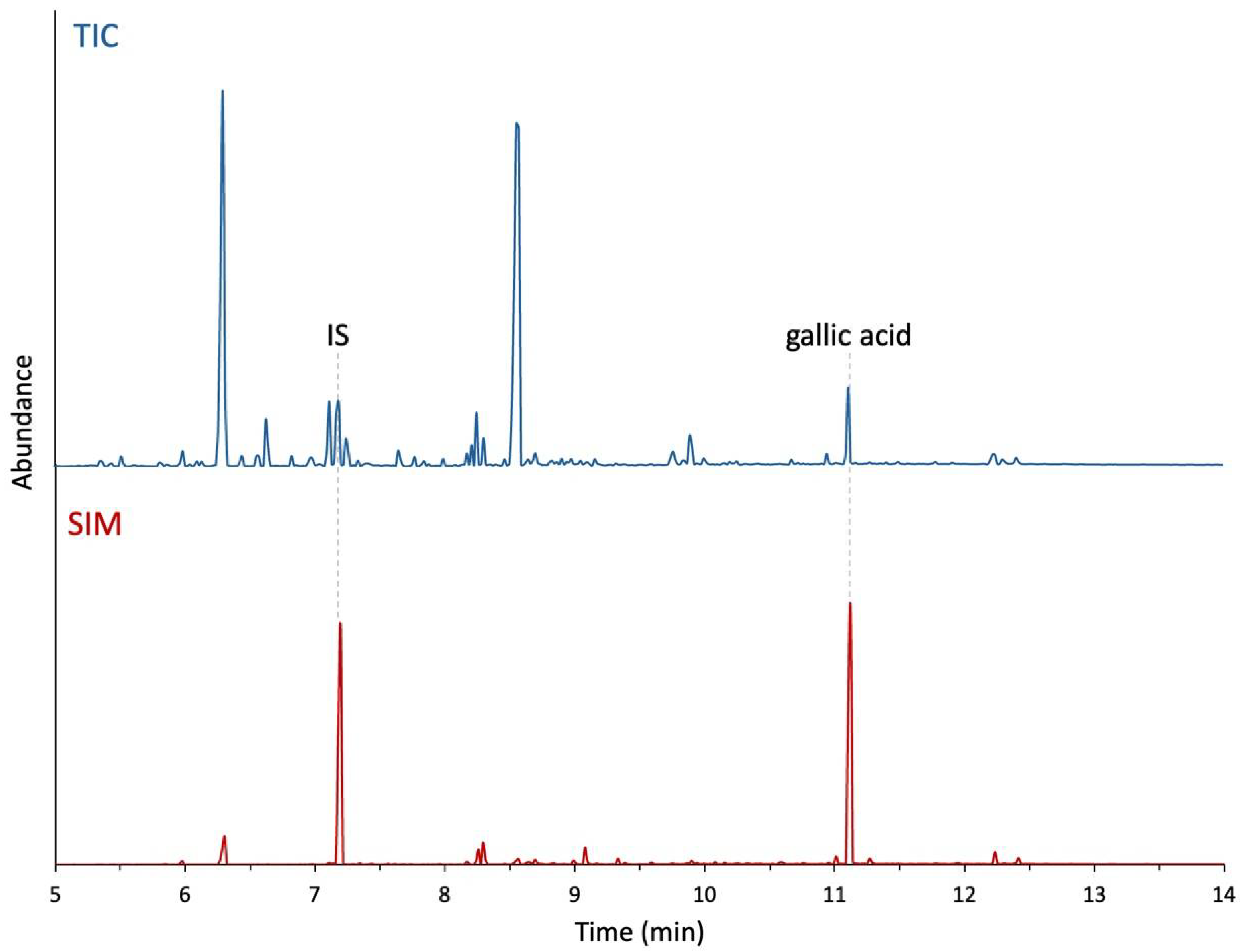Optimized Ethyl Chloroformate Derivatization Using a Box–Behnken Design for Gas Chromatography–Mass Spectrometry Quantification of Gallic Acid in Wine
Abstract
1. Introduction
2. Materials and Methods
2.1. Reagents and Standards
2.2. Optimization of Derivatization Conditions Using a Box–Behnken Design (BBD)
2.3. Optimized Extraction and Derivatization Procedure for Gallic Acid
2.4. GC-MS Analysis
2.5. Method Validation
2.6. Wine Analysis
3. Results and Discussion
3.1. Development of Gallic Acid Extraction and Derivatization Conditions
- the linear effects of ECF (X1) (p = 0.00447) and EtOH (X3) (p = 0.0177) were statistically significant.
- All quadratic terms—ECF2 (X12) (p = 0.0163), Pyr2 (X22) (p = 0.00075), and EtOH2 (X32) (p = 0.000697)—were highly significant. This underlines the non-linear relationships between each factor and the derivatization yield, validating the choice of a quadratic model and indicating the presence of optimal levels for each reagent.
- The interaction term between ECF and EtOH (X1·X3) was also statistically significant (p = 0.00426), implying that the effect of ECF on derivatization efficiency is dependent on the level of EtOH, and vice versa.
- Conversely, the linear effect of Pyr (X2) (p = 0.791) and the other two-way interaction terms, ECF–Pyr (X1·X2) (p = 0.834) and Pyr–EtOH (X2·X3) (p = 0.503), were not statistically significant (p > 0.05).

3.2. Method Validation
3.3. Gallic Acid in Commercial Wines
4. Conclusions
Supplementary Materials
Author Contributions
Funding
Data Availability Statement
Conflicts of Interest
Abbreviations
| ANOVA | Analysis of Variance |
| BBD | Box–Behnken Design |
| CV | Coefficient of Variation |
| ECF | Ethyl Chloroformate |
| EtOH | Ethanol |
| FID | Flame Ionization Detector |
| GC-MS | Gas Chromatography–Mass Spectrometry |
| IS | Internal Standard |
| LLOQ | Lower Limit of Quantitation |
| LOD | Limit of Detection |
| Pyr | Pyridine |
| SIM | Single Ion Monitoring |
| TIC | Total Ion Current |
References
- Wu, L.; Zhang, Y.; Prejanò, M.; Marino, T.; Russo, N.; Tao, Y.; Li, Y. Gallic acid improves color quality and stability of red wine via physico-chemical interaction and chemical transformation as revealed by thermodynamics, real wine dynamics and benchmark quantum mechanical calculations. Food Res. Int. 2024, 188, 114510. [Google Scholar] [CrossRef] [PubMed]
- Sterneder, S.; Stoeger, V.; Dugulin, C.A.; Liszt, K.I.; Di Pizio, A.; Korntheuer, K.; Dunkel, A.; Eder, R.; Ley, J.P.; Somoza, V. Astringent Gallic Acid in Red Wine Regulates Mechanisms of Gastric Acid Secretion via Activation of Bitter Taste Sensing Receptor TAS2R4. J. Agric. Food Chem. 2021, 69, 10550. [Google Scholar] [CrossRef]
- Gutiérrez-Escobar, R.; Aliaño-González, M.J.; Cantos-Villar, E. Wine Polyphenol Content and Its Influence on Wine Quality and Properties: A Review. Molecules 2021, 26, 718. [Google Scholar] [CrossRef] [PubMed]
- Wang, C.; Wang, C.; Tang, K.; Rao, Z.; Chen, J. Effects of Different Aging Methods on the Phenolic Compounds and Antioxidant Activity of Red Wine. Fermentation 2022, 8, 592. [Google Scholar] [CrossRef]
- Liu, Y.; Zhang, B.; He, F.; Duan, C.Q.; Shi, Y. The Influence of Prefermentative Addition of Gallic Acid on the Phenolic Composition and Chromatic Characteristics of Cabernet Sauvignon Wines. J. Food Sci. 2016, 81, C1669. [Google Scholar] [CrossRef] [PubMed]
- Javorský, J.; Král, M.; Šnirc, M.; Árvay, J.; Tremlová, B.; Dordević, D. Characterization of Moravian Wines by Selected Chemical Parameters. Separations 2021, 8, 89. [Google Scholar] [CrossRef]
- Sagdicoglu Celep, A.G.; Demirkaya, A.; Kondolot Solak, E. Antioxidant and anticancer activities of gallic acid loaded sodium alginate microspheres on colon cancer. Curr. Appl. Phys. 2022, 40, 30. [Google Scholar] [CrossRef]
- Keyvani-Ghamsari, S.; Rahimi, M.; Khorsandi, K. An update on the potential mechanism of gallic acid as an antibacterial and anticancer agent. Food Sci. Nutr. 2023, 11, 5856. [Google Scholar] [CrossRef]
- Hadidi, M.; Liñán-Atero, R.; Tarahi, M.; Christodoulou, M.C.; Aghababaei, F. The Potential Health Benefits of Gallic Acid: Therapeutic and Food Applications. Antioxidants 2024, 13, 1001. [Google Scholar] [CrossRef]
- Varzaru, I.; Untea, A.E.; Oancea, A.G.; Saracila, M.; Vlaicu, P.A. Bioactives in Berry Fruits with Emphasis on In Vitro Bioaccessibility for Human Nutrition. Separations 2024, 11, 286. [Google Scholar] [CrossRef]
- Wang, Y.; Wu, S.; Li, Q.; Lang, W.; Li, W.; Jiang, X.; Wan, Z.; Chen, J.; Wang, H. Epigallocatechin-3-gallate: A phytochemical as a promising drug candidate for the treatment of Parkinson’s disease. Front. Pharmacol. 2022, 13, 977521. [Google Scholar] [CrossRef] [PubMed]
- Tripathi, D.K.; Nagar, N.; Kumar, V.; Joshi, N.; Roy, P.; Poluri, K.M. Gallate Moiety of Catechin Is Essential for Inhibiting CCL2 Chemokine-Mediated Monocyte Recruitment. J. Agric. Food Chem. 2023, 71, 4990. [Google Scholar] [CrossRef]
- Bontpart, T.; Marlin, T.; Vialet, S.; Guiraud, J.L.; Pinasseau, L.; Meudec, E.; Sommerer, N.; Cheynier, V.; Terrier, N. Two shikimate dehydrogenases, VvSDH3 and VvSDH4, are involved in gallic acid biosynthesis in grapevine. J. Exp. Bot. 2016, 67, 3537. [Google Scholar] [CrossRef]
- Fernandes, F.H.A.; Salgado, H.R.N. Gallic Acid: Review of the Methods of Determination and Quantification. Crit. Rev. Anal. Chem. 2016, 46, 257. [Google Scholar] [CrossRef]
- Agatonovic-Kustrin, S.; Hettiarachchi, C.G.; Morton, D.W.; Razic, S. Analysis of phenolics in wine by high performance thin-layer chromatography with gradient elution and high resolution plate imaging. J. Pharm. Biomed. Anal. 2015, 102, 93. [Google Scholar] [CrossRef] [PubMed]
- Lingwan, M.; Masakapalli, S.K. A robust method of extraction and GC-MS analysis of Monophenols exhibited UV-B mediated accumulation in Arabidopsis. Physiol. Mol. Biol. Plants 2022, 28, 533. [Google Scholar] [CrossRef] [PubMed]
- Zhang, H.; Zhou, D.D.; Yang, F.Q.; Qian, Z.M.; Li, C.H.; Li, W.J.; Wang, S.P.; Wang, Y.T. Modulation of electroosmotic flow in capillary electrophoresis by plant polyphenol-inspired gallic acid/polyethyleneimine coatings: Analysis of small molecules. J. Chromatogr. B 2019, 1124, 7. [Google Scholar] [CrossRef] [PubMed]
- Wang, L.; Halquist, M.S.; Sweet, D.H. Simultaneous determination of gallic acid and gentisic acid in organic anion transporter expressing cells by liquid chromatography–tandem mass spectrometry. J. Chromatogr. B 2013, 937, 91. [Google Scholar] [CrossRef]
- Engström, M.T.; Pälijärvi, M.; Salminen, J.P. Rapid Fingerprint Analysis of Plant Extracts for Ellagitannins, Gallic Acid, and Quinic Acid Derivatives and Quercetin-, Kaempferol- and Myricetin-Based Flavonol Glycosides by UPLC-QqQ-MS/MS. J. Agric. Food Chem. 2015, 63, 4068. [Google Scholar] [CrossRef]
- Qiu, Y.; Su, M.; Liu, Y.; Chen, M.; Gu, J.; Zhang, J.; Jia, W. Application of ethyl chloroformate derivatization for gas chromatography–mass spectrometry based metabonomic profiling. Anal. Chim. Acta 2007, 583, 277. [Google Scholar] [CrossRef]
- Hušek, P. Chloroformates in gas chromatography as general purpose derivatizing agents. J. Chromatogr. B Biomed. Sci. Appl. 1998, 717, 57. [Google Scholar] [CrossRef]
- Francioso, A.; Laštovičková, L.; Mosca, L.; Boffi, A.; Bonamore, A.; Macone, A. Gas Chromatographic–Mass Spectrometric Method for the Simultaneous Determination of Resveratrol Isomers and 2,4,6-Trihydroxyphenanthrene in Red Wines Exposed to UV-Light. J. Agric. Food Chem. 2019, 67, 11752. [Google Scholar] [CrossRef]
- Sobolevsky, T.G.; Revelsky, A.I.; Miller, B.; Oriedo, V.; Chernetsova, E.S.; Revelsky, I.A. Comparison of silylation and esterification/acylation procedures in GC-MS analysis of amino acids. J. Sep. Sci. 2023, 26, 1474. [Google Scholar] [CrossRef]
- Citová, I.; Sladkovský, R.; Solich, P. Analysis of phenolic acids as chloroformate derivatives using solid phase microextraction–gas chromatography. Anal. Chim. Acta 2006, 573–574, 231. [Google Scholar] [CrossRef]
- Di Fabio, E.; Incocciati, A.; Palombarini, F.; Boffi, A.; Bonamore, A.; Macone, A. Ethylchloroformate Derivatization for GC–MS Analysis of Resveratrol Isomers in Red Wine. Molecules 2020, 25, 4603. [Google Scholar] [CrossRef]
- Incocciati, A.; Di Fabio, E.; Boffi, A.; Bonamore, A.; Macone, A. Rapid and Simultaneous Determination of Free Aromatic Carboxylic Acids and Phenols in Commercial Juices by GC-MS after Ethyl Chloroformate Derivatization. Separations 2022, 9, 9. [Google Scholar] [CrossRef]
- Ferreira, S.L.C.; Bruns, R.E.; Ferreira, H.S.; Matos, G.D.; David, J.M.; Brandão, G.C.; da Silva, E.G.P.; Portugal, L.A.; dos Reis, P.S.; Souza, A.S.; et al. Box-Behnken design: An alternative for the optimization of analytical methods. Anal. Chim. Acta 2007, 597, 79. [Google Scholar] [CrossRef]
- Demiray, H.; Dibek, M.E.; Özel, O. Optimization of betulinic and ursolic acids and phenolics extraction from endemic Rosa pisiformis using Box-Behnken design in relation to cytotoxic activities. Sci. Rep. 2025, 15, 1228. [Google Scholar] [CrossRef] [PubMed]
- Nardelli, V.; D’Amico, V.; Della Rovere, I.; Casamassima, F.; Marchesiello, W.M.V.; Nardiello, D.; Quinto, M. Box Behnken design-based optimized extraction of non-dioxin-like PCBs for GC-ECD and GC-MS analyses in milk samples. Emerg. Contam. 2020, 6, 303. [Google Scholar] [CrossRef]
- Park, Y.-R.; Lee, B.-S. Solubility of Gallic Acid in Single and Mixed Solvents. Separations 2024, 11, 36. [Google Scholar] [CrossRef]
- Opekar, S.; Kvíčala, J.; Moos, M.; Pejchal, V.; Šimek, P. Mechanism of Alkyl Chloroformate-Mediated Esterification of Carboxylic Acids in Aqueous Media. J. Org. Chem. 2021, 86, 16293. [Google Scholar] [CrossRef] [PubMed]
- Eslami, A.C.; Pasanphan, W.; Wagner, B.A.; Buettner, G.R. Free radicals produced by the oxidation of gallic acid: An electron paramagnetic resonance study. Chem. Cent. J. 2010, 4, 15. [Google Scholar] [CrossRef] [PubMed]
- Hostnik, G.; Tošović, J.; Štumpf, S.; Petek, A.; Bren, U. The influence of pH on UV/Vis spectra of gallic and ellagic acid: A combined experimental and computational study. Spectrochim. Acta Part A Mol. Biomol. Spectrosc. 2022, 267, 120472. [Google Scholar] [CrossRef]
- Friedman, M.; Jürgens, H.S. Effect of pH on the Stability of Plant Phenolic Compounds. J. Agric. Food Chem. 2000, 48, 2101. [Google Scholar] [CrossRef] [PubMed]
- Marino, T.; Galano, A.; Russo, N. Radical Scavenging Ability of Gallic Acid toward OH and OOH Radicals. Reaction Mechanism and Rate Constants from the Density Functional Theory. J. Phys. Chem. B 2014, 118, 10380. [Google Scholar] [CrossRef]
- The Fitness for Purpose of Analytical Methods. Available online: https://www.eurachem.org/images/stories/Guides/pdf/MV_guide_3rd_ed_V1_EN.pdf (accessed on 11 June 2025).
- Burns, J.; Gardner, P.T.; O’Neil, J.; Crawford, S.; Morecroft, I.; McPhail, D.B.; Lister, C.; Matthews, D.; MacLean, M.R.; Lean, M.E.J.; et al. Relationship among Antioxidant Activity, Vasodilation Capacity, and Phenolic Content of Red Wines. J. Agric. Food Chem. 2000, 48, 220. [Google Scholar] [CrossRef]
- Garcia-Viñola, V.; Ruiz-de-Villa, C.; Gombau, J.; Poblet, M.; Bordons, A.; Reguant, C.; Rozès, N. Simultaneous Analysis of Organic Acids, Glycerol and Phenolic Acids in Wines Using Gas Chromatography-Mass Spectrometry. Foods 2024, 13, 186. [Google Scholar] [CrossRef]




| Range (µg/mL) | Slope | Intercept | R2 | LLOQ (µg/mL) | LOD (µg/mL) | Concentration (µg/mL) | Accuracy (Recovery%) | Precision (CV%) | |
|---|---|---|---|---|---|---|---|---|---|
| Gallic acid | 5–1000 | 0.0071 | 0.0371 | 0.9991 | 5 | 0.5 | 50 | 101.6% | 3.36% |
| 500 | 101.0% | 4.56% |
| No. | Wine | Winemaking | Vintage | Region/Country | Varieties | Gallic Acid * (µg/mL) |
|---|---|---|---|---|---|---|
| 1 | Red | Conventional | 2021 | Lazio, Italy | Montepulciano, Cabernet Franc, Merlot | 371 |
| 2 | Red | Conventional | 2019 | Toscana, Italy | Brunello di Montalcino | 297 |
| 3 | Red | Conventional | 2022 | Sicilia, Italy | Nerello Mascalese | 217 |
| 4 | Red | Conventional | 2023 | Toscana, Italy | Sangiovese, Cabernet Sauvignon | 151 |
| 5 | Red | Conventional | 2022 | Abruzzo, Italy | Montepulciano | 27 |
| 6 | Red | Conventional | 2023 | Puglia, Italy | Negroamaro | 41 |
| 7 | Red | Conventional | 2023 | Abruzzo, Italy | Montepulciano | 51 |
| 8 | Red | Conventional | 2023 | California, USA | Cabernet Sauvignon | 79 |
| 9 | Red | Conventional | 2023 | Lazio, Italy | Primitivo | 62 |
| 10 | Red | Natural | 2020 | Lazio, Italy | Sangiovese, Grechetto | 34 |
| 11 | Red | Natural | 2022 | Toscana, Italy | Sangiovese | 188 |
| 12 | Red | Natural | 2023 | Lombardia, Italy | Croatina, Barbera, Vespolina, Uva Rara | 56 |
| 13 | Red | Natural | 2022 | Vaucluse, France | Caladoc, Grenache, Cinsault | 27 |
| 14 | Red | Natural | 2021 | Galicia, Spain | Garnacha Tintorera, Mencia | 657 |
| 15 | Red | Natural | 2023 | Lazio, Italy | Sangiovese, Cesanese | 6 |
| 16 | Red | Natural | 2021 | Toscana, Italy | Sangiovese | 11 |
| 17 | White | Conventional | 2023 | Sicilia, Italy | Chardonnay, Insolia | 0 |
| 18 | White | Conventional | 2023 | Alto Adige, Italy | Gewürztraminer | 0 |
| 19 | White | Conventional | 2023 | Sardegna, Italy | Vermentino | 0 |
| 20 | White | Conventional | 2023 | Sicilia, Italy | Grecanico, Insolia | 0 |
| 21 | White | Natural | 2022 | Alto Adige, Italy | Viogner | 0 |
| 22 | White | Natural | 2021 | Lazio, Italy | Malvasia dei Castelli | 5 |
| 23 | White | Natural | 2022 | Campania, Italy | Falanghina | 6 |
| 24 | White | Natural | 2023 | Campania, Italy | Falanghina | 5 |
Disclaimer/Publisher’s Note: The statements, opinions and data contained in all publications are solely those of the individual author(s) and contributor(s) and not of MDPI and/or the editor(s). MDPI and/or the editor(s) disclaim responsibility for any injury to people or property resulting from any ideas, methods, instructions or products referred to in the content. |
© 2025 by the authors. Licensee MDPI, Basel, Switzerland. This article is an open access article distributed under the terms and conditions of the Creative Commons Attribution (CC BY) license (https://creativecommons.org/licenses/by/4.0/).
Share and Cite
Botta, S.; Piacentini, R.; Cappelletti, C.; Incocciati, A.; Boffi, A.; Bonamore, A.; Macone, A. Optimized Ethyl Chloroformate Derivatization Using a Box–Behnken Design for Gas Chromatography–Mass Spectrometry Quantification of Gallic Acid in Wine. Separations 2025, 12, 183. https://doi.org/10.3390/separations12070183
Botta S, Piacentini R, Cappelletti C, Incocciati A, Boffi A, Bonamore A, Macone A. Optimized Ethyl Chloroformate Derivatization Using a Box–Behnken Design for Gas Chromatography–Mass Spectrometry Quantification of Gallic Acid in Wine. Separations. 2025; 12(7):183. https://doi.org/10.3390/separations12070183
Chicago/Turabian StyleBotta, Sofia, Roberta Piacentini, Chiara Cappelletti, Alessio Incocciati, Alberto Boffi, Alessandra Bonamore, and Alberto Macone. 2025. "Optimized Ethyl Chloroformate Derivatization Using a Box–Behnken Design for Gas Chromatography–Mass Spectrometry Quantification of Gallic Acid in Wine" Separations 12, no. 7: 183. https://doi.org/10.3390/separations12070183
APA StyleBotta, S., Piacentini, R., Cappelletti, C., Incocciati, A., Boffi, A., Bonamore, A., & Macone, A. (2025). Optimized Ethyl Chloroformate Derivatization Using a Box–Behnken Design for Gas Chromatography–Mass Spectrometry Quantification of Gallic Acid in Wine. Separations, 12(7), 183. https://doi.org/10.3390/separations12070183








